Quiet luxury in India: Elites embrace global trend, redefining it on their own t
Just like in the rest of the world, quiet luxury in India is a form of social shorthand, a discreet signal recognizable only to those within the same elite circles
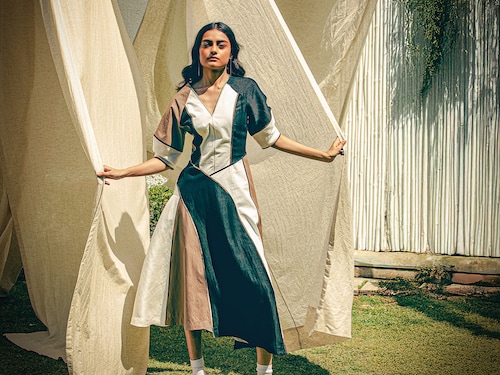

You don’t fully grasp exactly how the American TV series Succession fuelled a fascination with the lives of the wealthy until you stumble upon an Instagram page zealously dedicated to the characters’ outfits. With over 185,000 followers, the account meticulously details the brands and price points of nearly every item of clothing on the show that won multiple awards over a course of about five years.
And just so you don’t go rummaging through each episode to spot ‘that’ jacket or ‘that’ watch, the Instagram handle adds the season and episode details as a bonus. The real curiosity though lies not in what brands the wealthy prefer, but with how these incredibly expensive clothes manage to look so surprisingly ordinary. That is, except for those with an eye for luxury fashion. And that’s how, in a brilliant bit of irony, ‘quiet luxury’ became the centre of attention.
“A lot of quiet luxury clothing is visually indistinguishable from what you’d find at Uniqlo. It might be a navy baby cashmere sweater, but it still looks like a normal navy crew neck to everyone else. This is essentially the problem with a lot of quiet luxury. It’s so quiet, it’s hard to visually distinguish from mass market clothes,” says Derek Guy, a Canada-based menswear writer and internet personality whose takes on men’s fashion have engaged, entertained and enraged many online.
The idea of a subdued aesthetic though is nothing new. In fact, it can be traced to the notions of ‘old money’, where inherited wealth was communicated through the impeccable cut of a suit, the quality of a cashmere sweater, or the texture of a leather handbag and not through ostentatious logos.
For Viraj Khanna, an artist and director of fashion brands AK|OK and Anamika Khanna, the spotlight on quiet luxury is not just a natural response to the “performative culture” on social media so prevalent nowadays, but also about knowledge and impact. “People are beginning to crave something more honest; not necessarily simpler, but more meaningful. People today can learn about the origins of what they wear, how something is made, and what it stands for, often with just a few clicks. This kind of awareness is powerful.”
But for Dal Chodha, who leads the BA Fashion Communication: Image & Promotion pathway at Central Saint Martins, London, quiet luxury is in many ways “incredibly conservative, and generic”. “Today, a stylish person in Brasilia is also stylish in Paris or Bengaluru. The idiosyncrasies of culture seemed to have been flattened out by the algorithms we are all subjected to,” he says.
While the Indian elite might not have a Succession of their own just yet, or an Instagram handle swooning over their everyday displays of ‘stealth wealth’, they certainly have their own version of the quiet luxury aesthetic.
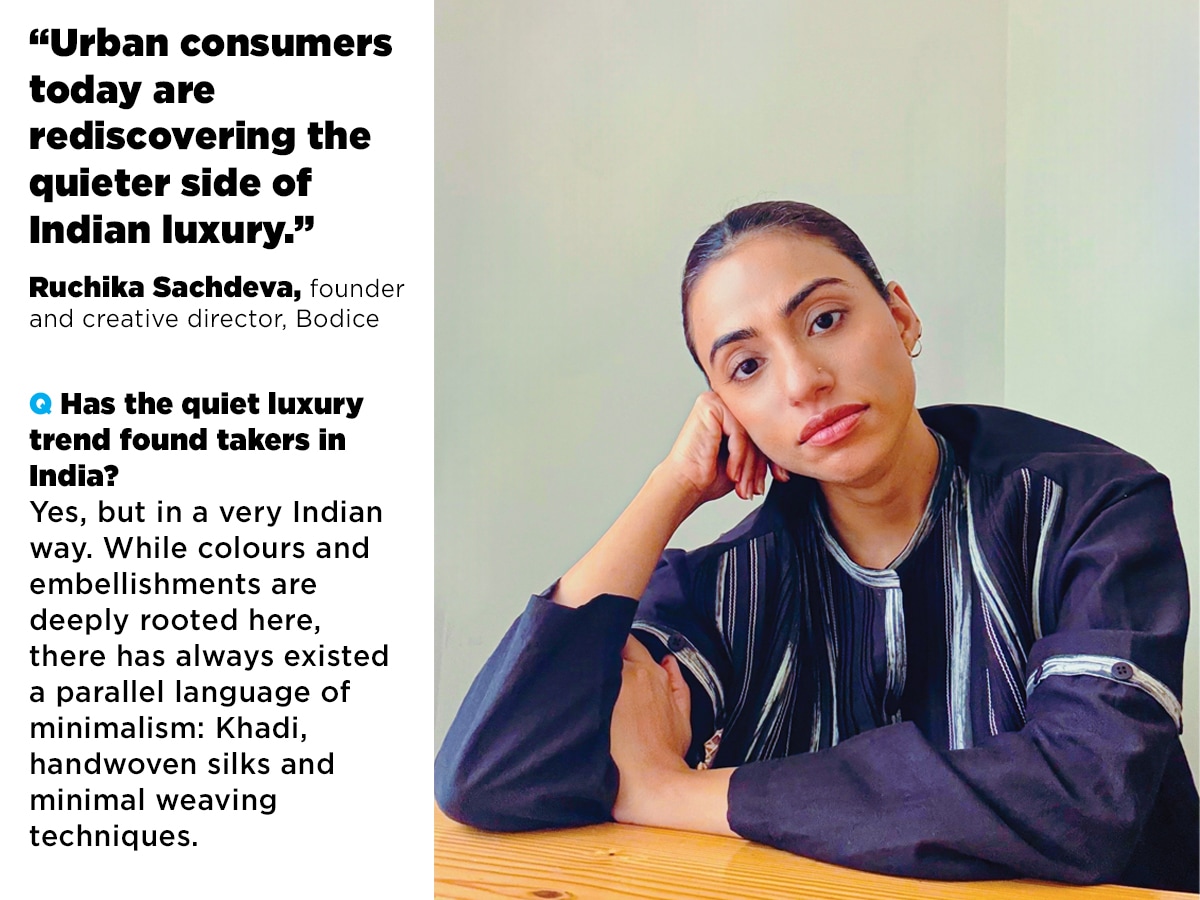
There is a certain flamboyance inherent in Indian clothing; a quality that makes it easily endearing yet difficult to tone down. And yet, as Ruchika Sachdeva, founder and creative director of fashion label Bodice, explains, quiet luxury has found its own base in India, albeit in a distinctively Indian way. For Bodice, quiet luxury is not just a fad, it’s the “foundation of its design language”. Sachdeva says, “Bodice has always been about precise tailoring, clean lines and thoughtful detail.”
She goes on to explain that “while colours and embellishments are deeply rooted here, there has always existed a parallel language of minimalism: Khadi, handwoven silks and minimal weaving techniques. Urban consumers today are rediscovering that quieter side of Indian luxury”.
Take, for instance, the beige silk saree worn by actor Aditi Rao Hydari at her wedding in September 2024, which many hailed as the perfect minimalist look for a South Indian bride. The saree was a custom Sabyasachi. “There is a growing desire among Indian consumers to understand what they’re buying —not just visually, but culturally and ethically. Handmade pieces, for instance, carry heritage and are often passed down through generations,” Khanna adds.
Ask Tanya Ghavri, celebrity stylist and co-founder of Dhoom Dham Company, who has worked with actors Katrina Kaif, Kareena Kapoor Khan and Sonam Kapoor Ahuja, and she will effortlessly list out a host of homegrown brands that cater to this aesthetic. In a world with Brunello Cucinelli, Hermès, Loro Piana and Metier, Ghavri says brands like Lovebirds, Atsu, Raw Mango, Péro, and Good Earth seamlessly balance Western and Indian sensibilities in their designs. For her, clothes designed by Meera Muzaffar Ali (House of Kotwara), Payal Khandwala, Anamika Khanna and Karan Torani (Torani India) “give you that quiet luxury feel”. “You will be wearing the most exquisite fabrics, prints and pieces that are made with so much time and effort. But it won’t bedazzle you, and it won’t be heavy,” she says.
Just like in the rest of the world, quiet luxury in India is a form of social shorthand, a discreet signal recognisable only to those within the same elite circles. And it isn’t thriving because of social media, but outside of it. “A quiet luxury customer is more intentional. They do their research. They are aware of the origins, the handwork, the stitching, and the story behind what they’re wearing. This is exactly the kind of clientele we’ve always had at Anamika Khanna,” Khanna explains.
For some, like Guy, the elaborate craftsmanship and creative design of Indian clothing don’t exactly fit the mould of quiet luxury. “I like Kardo, Kartik Research and 11.11; 18 East also makes clothes in India. There’s so much rich textile tradition in India, as well as skilled craftsmanship. But the lines that catch my eye are playing up those qualities, not playing them down.”
Chodha echoes this sentiment. He explains the term is being reinterpreted as a return to the true essence of luxury, which in India, is all about textiles. “I don’t think what Kartik Kumra [of Kartik Research] is doing with his label is quiet luxury. Is the ‘artisanal’ considered ‘quiet’? That’s the position I think needs unpacking.”
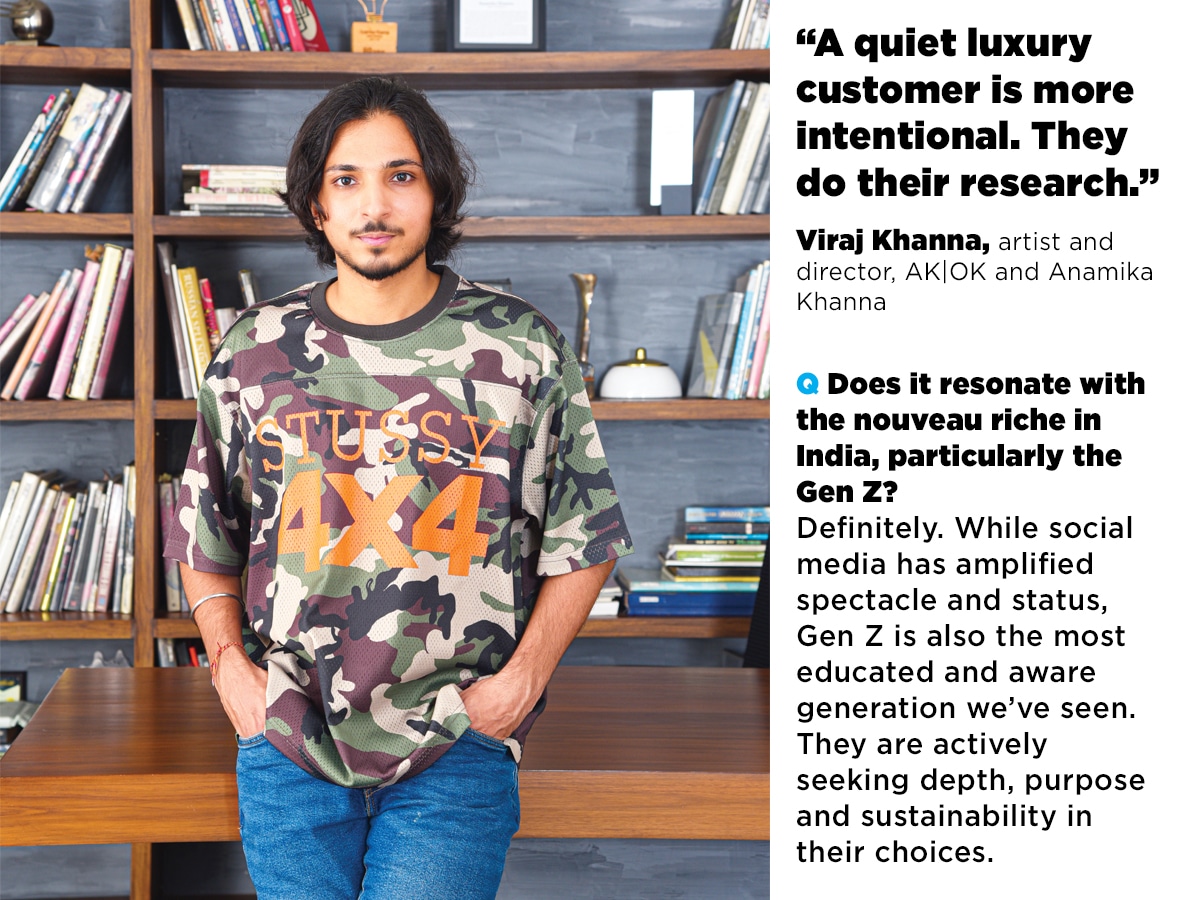
The paradox of mainstream luxury is that as it becomes more accessible to the masses, it loses its power as a true marker of being elite. Could quiet luxury, then, be a direct response to this democratisation of luxury?
“Whether it’s a Gucci or an LVMH, their sales have fallen, because the world is moving towards brands that are not in-your-face. Logo showing-off is not cool anymore,” Ghavri says.
It’s often said that only the wealthiest 1 percent, the crème de la crème, can afford the quiet luxury aesthetic. In India, the top 1 percent accounted for over 40 percent of the country’s total wealth in 2023, up from about 25 percent at the start of this century, according to the World Inequality Database.
Quiet luxury could also be a response to the online scrutiny of wealth and privilege, which has led to a certain unease among those who have it. According to Chodha: “In the last few years, with the positioning of ‘quiet luxury’, people have been trying to infer that they have access to good quality things whilst asserting a kind of humility. They do not want to shout about it, but they want you to know. I don’t think it is entirely genuine.”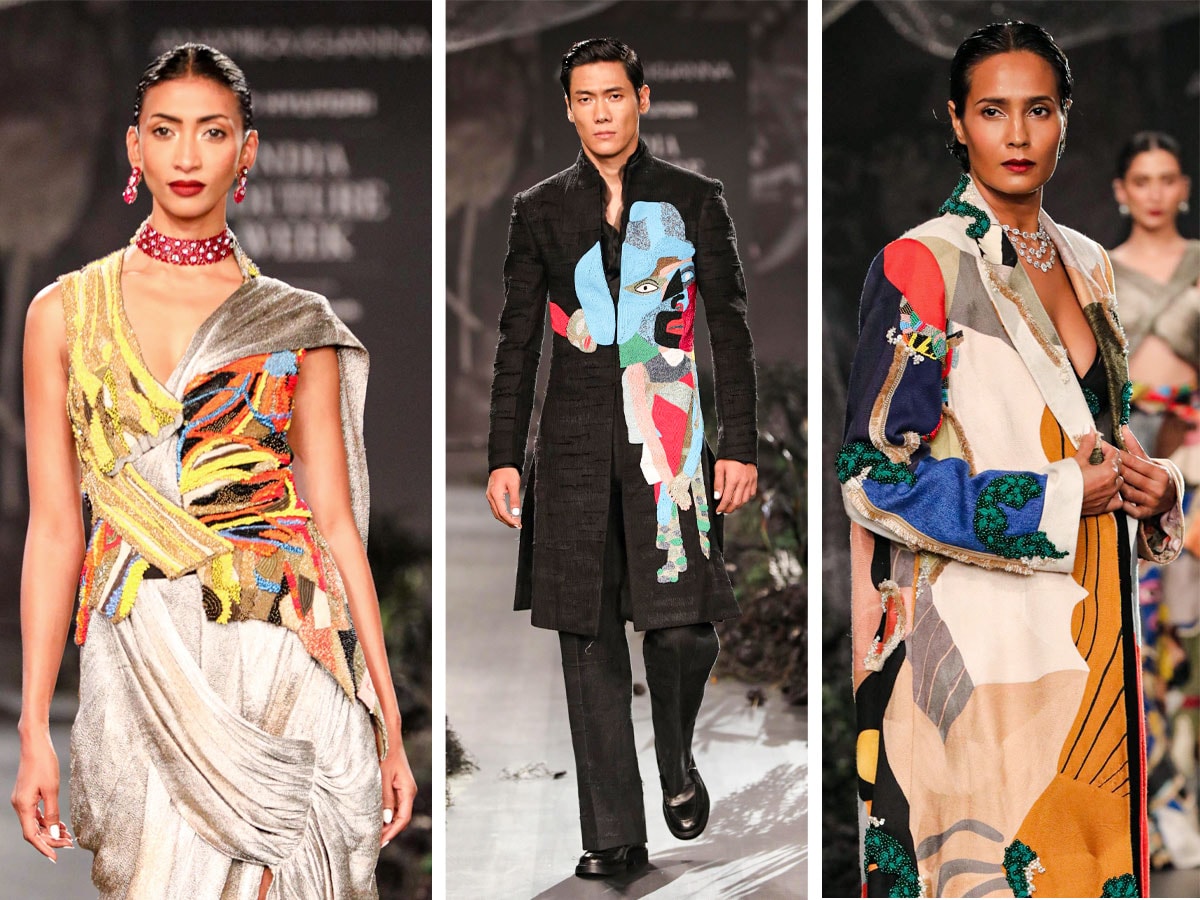
India’s millionaire population is one of the fastest growing in the world, surpassed perhaps only by China’s. As this new wealth is created, clothing and accessories are increasingly being seen as investments rather than disposable items. Are the truly affluent, then, trying to differentiate themselves?
Sanmitra Chitte, dean, School of Business, World University of Design, in Haryana believes that the West was always inclined to be more ‘silent’ than Indians, whether at festivals or at weddings. “We Indians love to flaunt what we have. There may be some amazing heirloom, but we may still look for a new Paithani [handwoven silk from Maharashtra] saree made from real gold or silver zari. That urge to show off wealth is at another level.”
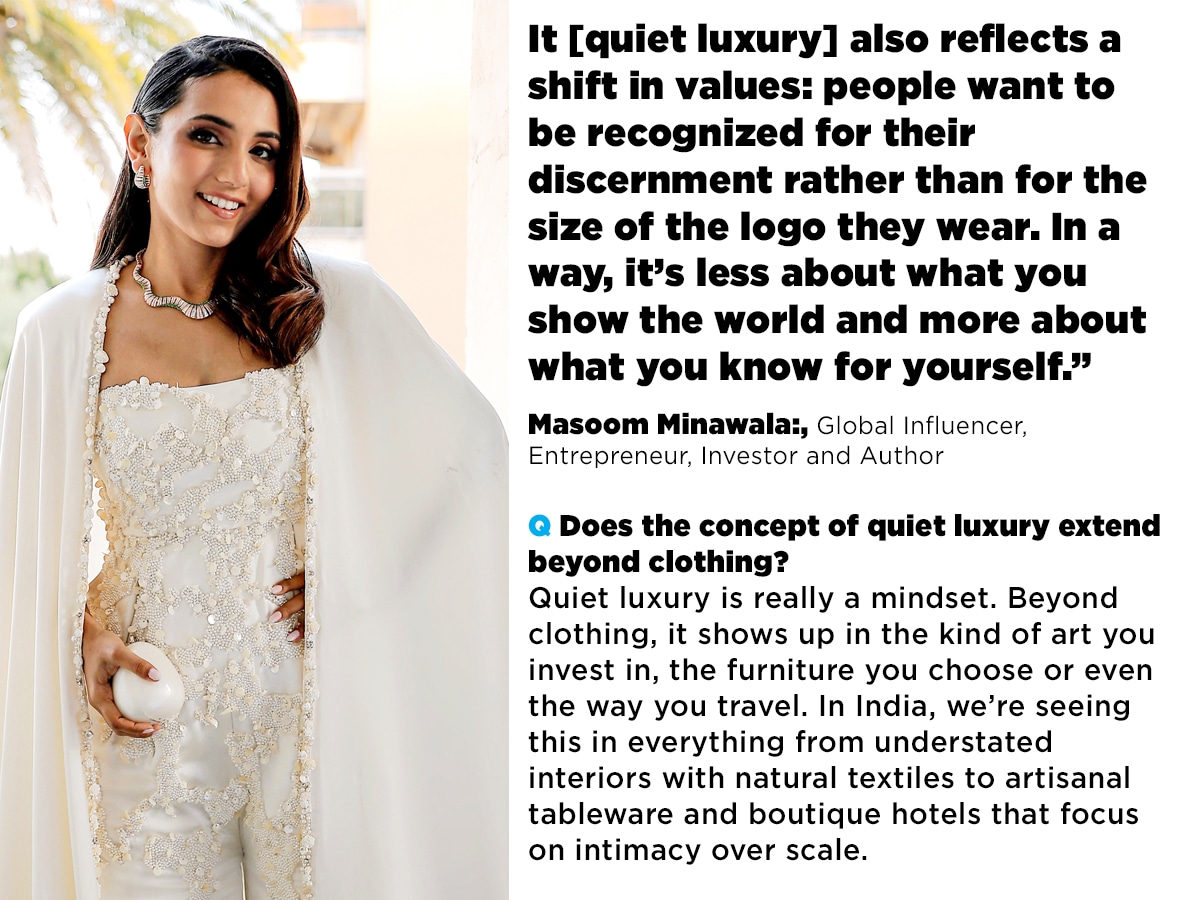
Beyond its aesthetic appeal, quiet luxury carries profound social and psychological implications. For consumers, it represents a shift from external validation to internal satisfaction. The confidence derived from wearing a quiet luxury piece comes not from the recognition of a brand by others, but from the wearer’s own appreciation for its quality and feel. It is a form of self-assurance that does not require an audience.
How then, does a generation on a steady diet of social media, for all intents and purposes, view this aesthetic? Turns out, there is no single answer.
Ghavri believes there are essentially two kinds of luxury shoppers among the Gen Z rich. There is the one that wants to be constantly seen wearing a new trend or a new design, and will usually resort to fast fashion and purchase the relatively cheaper brands (cheaper than quiet luxury brands but still luxury). “And then there are the Gen Z that come from a certain lineage and are really interested in slow fashion and in good brands that want to invest in good pieces, and which are sustainable in the long run,” she says. She believes actor Khushi Kapoor, among Gen Z actors, has a “real eye” for vintage pieces that may be expensive but are ones “she will use for a very, very long time”.
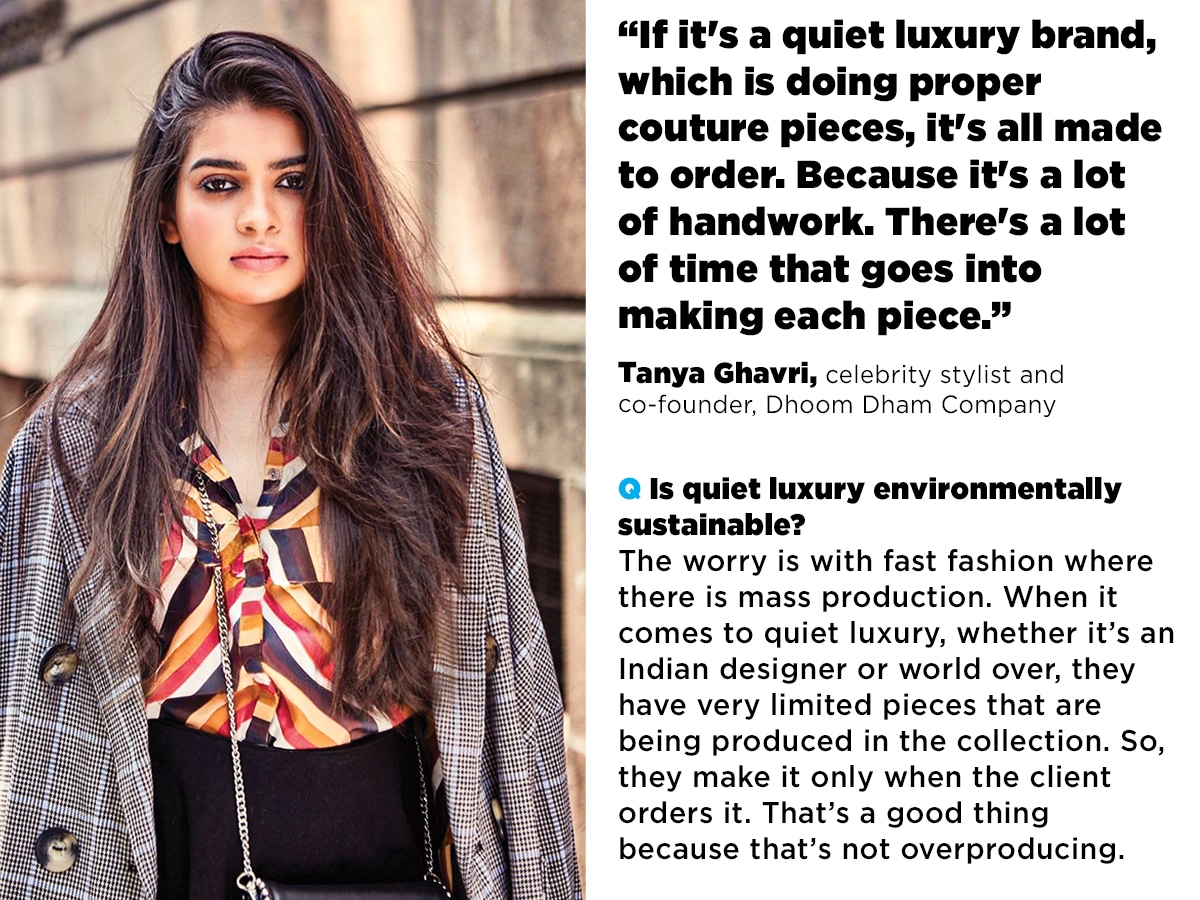
As celebrity culture fuelled logomania, particularly since the 1990s, the market for cheap knockoffs and pre-owned luxury products also boomed. According to one market estimate by the IMARC Group, India’s second-hand luxury goods market was worth almost $700 million last year and is expected to exceed $1.6 billion in the next eight years, growing at a rate of 10 percent. In the meantime, the overall luxury market in India is expected to grow at 9 percent.
Beyond simply experimenting with monogram designs, companies began to adapt their utility to reflect the demands of the times. Monograms evolved from a safeguard against counterfeiting to a status symbol. Who doesn’t recognise the iconic Louis Vuitton monogram and its signature interlocking letters? “Although branding is seen as the definitive indicator for luxury, the number of fake products in the market make it difficult for a person to flaunt it,” says Chitte.
But for a brand focussed on the quiet luxury aesthetic, which is defined by the absence of a logo, marketing becomes its monogram. “I think for a quite luxury brand, it’s very important how the campaign is shot. You create a little bit of FOMO [fear of missing out] about your brand and you create that value within yourself that you only dress certain people,” Ghavri explains. She points to Raw Mango founder Sanjay Garg as an example. While he stays true to his design aesthetic, he has also used social media to present his brand in an aspirational way.
Meanwhile, Sachdeva believes that luxury shouldn’t be “announced”; the weight of a fabric, the sharpness of a seam, the way something moves on the wearer’s body carry more authority than any logo. But she concedes that subtlety often takes time to gain some recognition. “But once a customer connects with it, they tend to stay loyal. It creates a deeper, more lasting relationship than trend-driven fashion,” she says.
The quiet luxury trend, whether for the old rich or the Gen Z, is far more than a simple style preference. It is a cultural narrative that reflects a deep-seated desire for authenticity, durability and a more private form of success. It challenges the very definition of luxury, the hyper-commercialised world of fast fashion and celebrity endorsements.
Quiet luxury suggests that true elegance whispers, rather than shouts, and that the most meaningful possessions are those that are built to last and valued for their intrinsic quality, not their external status.
First Published: Oct 06, 2025, 16:36
Subscribe Now